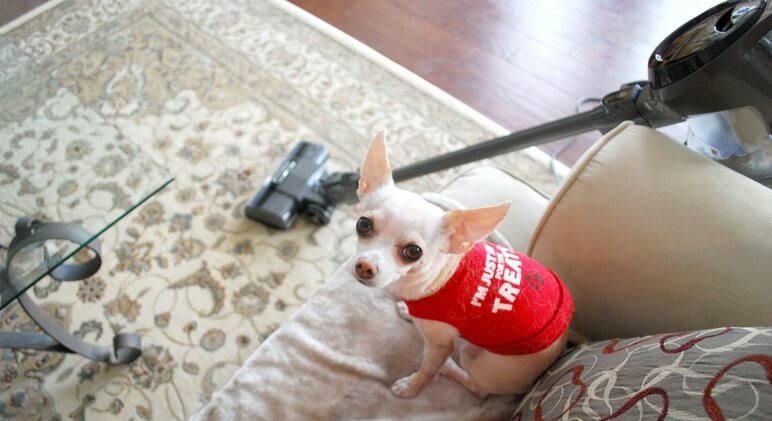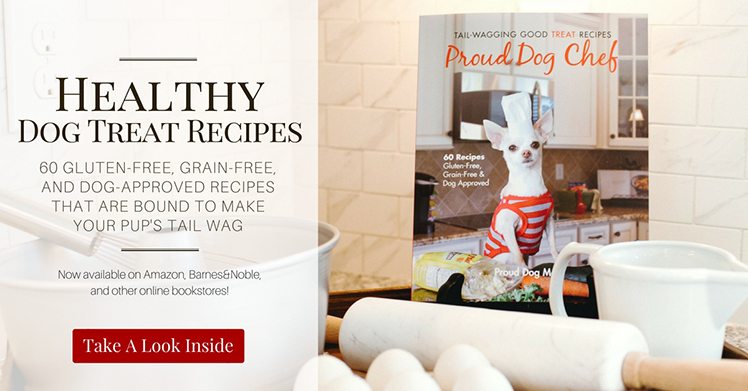It’s not uncommon for dogs to develop fears — whether it’s a fear of the groomer, the evil vacuum, strange swooshing noises coming from the washing machine, or a booming thunderstorm. I even received an email from one dog mom explaining that her pooch is afraid of the ceiling fan. So the big question becomes: What can you do to help your pooch? Read on to find out the common causes of canine phobia and tips to help your furry family member overcome his fears!
What Causes Doggy Fears?
This can be difficult – and sometimes impossible – to determine. But experts say, often times, fears are the result of:
- Poor socialization during puppyhood
- A former bad experience
- Attention-seeking
- Picking up on your negative vibe toward something
One of the best ways to help your dog overcome his fears is to replace any bad experiences or negative feelings with good ones!
How To Help Your Dog Overcome His Fears
1. Stay Calm
When we know our dogs are about to be put in a stressful situation, it’s natural for us to feel a bit anxious. For example, if you know your dog doesn’t deal well with shots, and you’re about to take your pup to the vet for his boosters, then your nerves may start acting up. But did you know your dog can actually sense your worry? I know it can be difficult, but try to stay as relaxed as possible to avoid transferring your stress onto your dog.
2. Stop Telling Your Dog “It’s Okay”
When your dog is put in a stressful situation, do you have a tendency to calmly repeat, “It’s okay … it’s okay”? Many of us are guilty! It’s a natural instinct. But while we may use this phrase with good intention, experts say our dogs perceive it to mean something bad is about to happen, which just winds up stressing them out more. It’s all about negative word association.
3. Don’t Reward Unwanted Behavior
When your dog is scared, do you immediately offer up pets, hugs, kisses, and cuddles? While it may be your way of soothing your fur kid’s anxiety, your dog thinks he’s getting rewarded for his behavior. Just think about it. He acts out and then you show him love. Makes sense, right? Instead of coddling your pup, try to ignore his initial outburst. Then, calmly toss him a toy or an interactive puzzle.
4. Treats, Treats, Treats
Dogs are very food-driven creatures. In an interview I did with Canine Behaviorist Kathy Reilly, she said:
“Work on changing his mind about particular triggers by associating something good with the something scary. In other words, if your dog is afraid of the mailman, try dropping yummy treats as soon as the mailman comes into view and don’t stop until the mailman is gone. With each practice, you will see your dog react less and less. This is because you have changed the association with the mailman. He is no longer a threat but a predictor of yummy treats. Over time, you will need fewer and fewer treats because your dog no longer fears the mailman.”
Similarly, if your dog is afraid of an object, like the vacuum, then turn it off and leave it nearby as you feed your pooch a yummy meal or toss him a few treats.
5. Reward Good Behavior
When your dog begins to control his emotions during stressful times then make sure to reward him! If your dog holds back growling at the vacuum or seems less phased by the washing machine, offer praise and a healthy treat. It may take some time, but he will eventually associate the positive reward with the person, place, or thing he was once afraid of.
Other Ideas To Help Ease Fear & Anxiety
- Exercise – Before your pooch comes face to face with whatever it is that’s scaring him, go for a run. Physical activity helps to stimulate the production of serotonin, a feel-good brain chemical. Plus, it also gets rid of any pent-up energy that can make an anxiety attack worse.
- Try A Thunder Jacket – A thunder jacket is a tightly fitting jacket that applies pressure to your dog’s body. The continuous pressure is believed to calm an anxious dog’s nerves. My friend’s dog has a thunder jacket and she swears by it. She isn’t the only dog mom who believes in the thunder jacket. They’re actually quite popular!
- Play Calming Music – Music can be extremely effective in calming your anxious dog. While you can simply turn on Pandora and play soothing music, there are playlists specifically designed for calming dog anxiety. For example, the company iCalmPet (previously called Through a Dog’s Ear) offers a selection of pet-calming tunes. They even sell a portable music player called the iCalmDog 2.0. It comes pre-loaded with 4 hours of clinically-tested music.
If your dog’s fears are extremely severe and pose a risk to his health/well-being then it’s time to consider enlisting the help of a local behaviorist.








